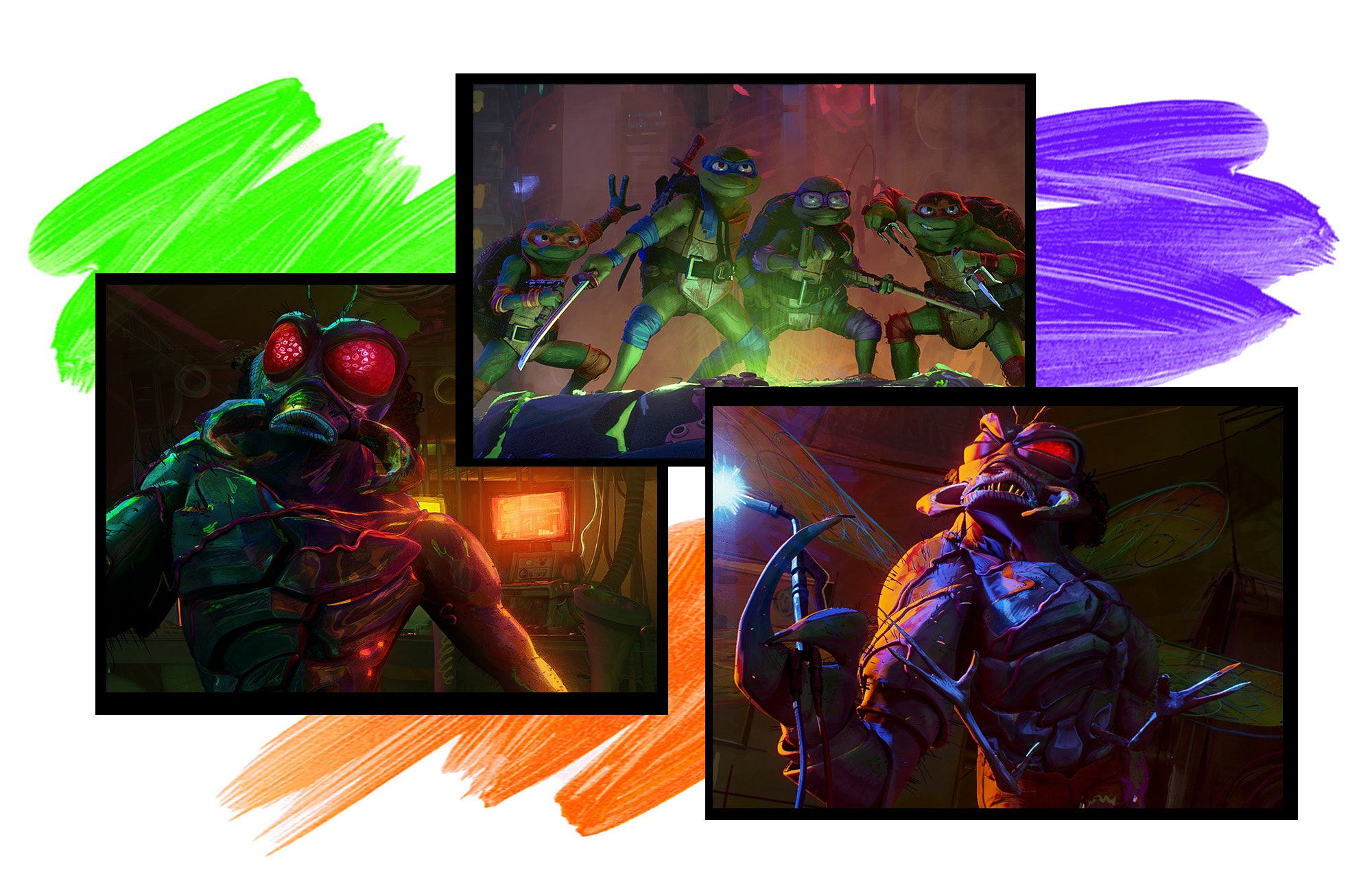"Migliore di Mark Ruffalo": dentro il finale selvaggio e gioioso di Teenage Mutant Ninja Turtles: Mutant Mayhem | Vanity Fair

Di Katey Rich
"Un piccolo cavallo? Non ho bisogno di quel cavallo." Secondo Seth Rogen, la battuta che sgonfia una scena climatica verso la fine di TMNT: Mutant Mayhem è stata improvvisata in una stanza di registrazione da Ice Cube, a cui è stato detto di immaginare cosa potrebbe dire un gigantesco mutante costruito con animali mentre calpesta Manhattan. Non è il tipo di cosa che un attore potrebbe facilmente evocare da solo, e per molto tempo nello sviluppo del film, il mutante doveva solo urlare, non parlare. Ma ad un certo punto, dice Rogen, "Abbiamo pensato, 'E se fosse questo mostrone gigante, ma suonasse ancora come Ice Cube?'"
Questo tipo di sviluppo della trama - e se accadesse questa cosa pazza? - diventa una parte importante della leggenda di Mutant Mayhem quando si parla con Rogen e Jeff Rowe, il regista del film, che hanno guidato il film attraverso una revisione della storia dopo l'altra per diventare una delle sorprese più piacevoli del 2023. Un progetto delle Tartarughe Ninja con un grande enfasi sulla parte "adolescente", ha l'inesperienza dolce di Superbad di Rogen e Evan Goldberg, a cui fanno spesso riferimento quando parlano di Mutant Mayhem. Ma è anche un film d'azione inventivo, divertente e senza fine, che culmina in una battaglia kaiju per le strade di New York che concede spazio allo sviluppo dei personaggi per tutte e quattro le tartarughe; una trasmissione di notizie eroica per la loro amica April O'Neil; e un gruppo di newyorkesi che si uniscono in quello che Rogen chiama liberamente il loro "momento Spider-Man 2". Ecco come l'hanno reso possibile.
In tutto Mutant Mayhem, i nostri eroi adolescenti Leo, Donnie, Raph e Mikey hanno solo voluto essere accettati dalla società umana. Hanno deciso che abbattere l'infame Superfly (Ice Cube) e la sua famiglia di mutanti è il modo per farlo. Ma i loro sforzi creano solo una versione più grande e più spaventosa di Superfly che si abbatte su New York City. Mentre inizia il climax d'azione del film, le tartarughe stanno marciando verso Manhattan con un'arma che pensano possa risolvere tutto e far sì che gli umani li accettino finalmente. Allo stesso tempo, il loro padre adottivo Splinter (Jackie Chan) si è reso conto che deve lasciar marciare i suoi figli verso il pericolo, ma non ha ancora smesso di temere gli umani. Tutti, alla fine, hanno ancora qualcosa da imparare.
"È qualcosa a cui sto sempre cercando di arrivare, e in realtà penso che l'abbiamo fatto bene in quel momento: lo spettatore ha l'impressione che gli stai dando la risposta, ma in realtà è una risposta incompleta", dice Rogen. Quando questo approccio funziona bene, dice, il pubblico prova l'emozione di una soluzione ancora migliore che viene rivelata insieme ai personaggi. "Oggi ci sono standard molto alti per i film d'animazione. È stato fatto uno sforzo molto cosciente per far sì che il terzo atto continui a offrire questo tipo di catarsi emotiva. È bello, penso, che anche il pubblico possa fare questo viaggio."
Come molti film d'animazione, la storia di Mutant Mayhem è stata trasformata radicalmente durante la produzione. Sono arrivati molto avanti nel processo con un mostro del terzo atto che non era affatto Superfly: a un certo punto, il nemico era creato da Shredder, l'iconico villain delle Tartarughe Ninja che ora appare solo in una breve suggestione alla fine del film. Anche se la parte della storia non funzionava, l'animazione era già iniziata. Come la mette Rowe, "Avevamo già iniziato a costruirlo ed era un assetto grande, costoso e complicato... E poi, a un certo punto, Seth ha pensato, 'Non avrebbe più senso - invece che Superfly crei un mostro, lui stesso diventa il mostro?'"
Il risultato, dice Rowe, è stato una corsa di 48 ore per trasformare il mostro preesistente - un insieme di animali che formavano una forma vagamente simile a Godzilla - in qualcosa che potenzialmente poteva essere una volta l'insetto mutante Superfly. "Era come, 'Possiamo mettere ali e occhi di mosca su questo mostruoso gigante balena?'" ricorda Rowe. "Quando l'abbiamo fatto, la storia ha trovato il suo posto. Ma se non avessimo già speso molto tempo ed energia per quell'assetto, potremmo avere avuto un finale diverso per il film."
Ci sono cinque sceneggiatori accreditati per il film, con Dan Hernandez e Benji Samit che ricevono il credito per il prodotto finale insieme a Rogen, Goldberg e Rowe. Per Rogen, che ha iniziato a scrivere sceneggiature con Goldberg quando aveva 13 anni e negli ultimi anni si è dedicato alla produzione di serie TV come The Boys e Preacher, una squadra così grande è solo un vantaggio. "Abbiamo davvero testato e esplorato", dice del processo di scrittura a cinque, "ed è bello dell'animazione: la metti in piedi, la guardi e vedi se funziona".
After the turtles have tried and failed once to take down Superfly, they regroup and give each other a pep talk, with each turtle reminded of his unique strengths. The distinction among the turtles was essential for the toy-buying fans of the early ’90s—Leonard is the leader, Michelangelo’s a party dude—but for Rogen and Rowe, the team dynamic was much more important to the story they wanted to tell. That was one thing, actually, they didn’t want to steal from Superbad. “We very much didn’t want the story to be about the conflict that they had as characters amongst themselves—mostly because that’s just a thing we’ve done a lot,” Rogen says, “They have conflict, but together they’re a unit and they love each other, and they’re all they’ve ever had.”
Rowe contrasts it to his work on 2021’s Mitchells vs. the Machines, which he cowrote with director Michael Rianda; the film centers on a family of four, but the father and daughter carry the key emotional beats. “Any time we tried to do that with this film, it didn’t feel right,” Rowe says. “The other characters felt underserved.” Eventually he learned that the performances from the teenage voice actors (Micah Abbey, Shamon Brown Jr., Nicolas Cantu, and Brady Noon) would allow each character to be distinct even while being united in their goals. “When we started recording them all together and the way they would all riff with each other,” Rowe says, “They just felt equal.”
Which brings us to Mark Ruffalo. When the boys are doubting themselves the most, Leo reminds his brother Mikey of what he does “better than anyone—even Mark Ruffalo.” The answer is “improvise,” a callback to an earlier throwaway joke in the film about a supposedly improvised scene in Avengers: Endgame, and it’s the moment that gives Mikey the boost he needs to move forward. Except, according to Rogen, “I actually have no idea if it was improvised or not.” And they haven’t heard from Ruffalo. “But I hope if he sees it, he’s happy about it.”
After the turtles regroup, they resume their fight against Superfly, but they’re quickly outmatched. As the monster squeezes them in his fist (a giant lobster claw, of course), Splinter is knocked to the ground and cowers as a group of humans approach him—only to offer to help take him to the hospital, or a veterinarian. Thus begins the Spider-Man 2–esque sequence of humans banding together to help save the day, which both non-New Yorkers Rogen and Rowe swear matches their experience in the city. “I was there a few months ago when there was that insane rainstorm and the whole city was flooding, and I just sat in a furniture store with 50 people for an hour,” says Rogen. “And it was lovely. It was a sense of community that New York has.”
Given that the turtles and Splinter had spent the entire movie to this point ostracized by society, Rowe says, “It felt important to give humanity a win if we wanted to end in a place with the turtles being accepted by them.” As the sequence moves forward, it ends with the four turtles tossing the Superfly-destroying weapon back and forth to each other in a fluid bit of action that, Rowe says, wasn’t nearly as good until their director of cinematography Kent Seki stepped in. “He was like, ‘I think this needs to be better. I’m going to try something,’” Rowe remembers, “And everyone was like, ‘Kent, we don’t have time. We cannot try anything…. It’s just not going to work.’ And then when we saw it, we’re like, we can’t unsee this. He was basically going to hold everyone hostage with quality work, which is the best situation.”




